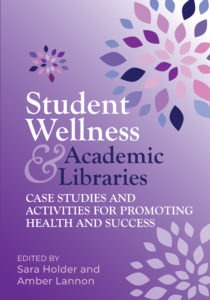Learn about the benefits of constructing a multi-year internship from a MLIS student's perspective.

What’s involved with being an editor for a multiauthor volume?
By Sara Holder and Amber Lannon
Sharing our professional knowledge and experience through writing is something we value collectively as a profession. For many librarians, it’s a requirement of tenure and promotion. When we think about scholarly writing, the journal article is probably the first format that comes to mind, with book chapters and monographs following close behind. What might not be immediately obvious as a way of participating in scholarship is being an editor of a multiauthor volume. And yet, we have found that being the editor (or editors) on such a collaborative project is a meaningful way to contribute to the literature related to our work and research in addition to strengthening our professional skillset(s).

The editorial process
Step one: Submitting a proposal to a publisher
Multiauthor volumes (also called edited volumes or edited scholarly monographs) are collections of pieces by many different authors compiled into a single volume. These works often bring together a variety of perspectives, approaches, case studies or research on a single topic. For these publications the editor(s) will have a very important role in shaping the volume and normally have significant experience with the topic to inform this work.
The first step in editing a volume is a proposal to a publisher, which should include how this volume will fill a gap in the literature, who the audience is, and some sample chapter topics. Proposals are most often reviewed by an editorial board, a process that will provide feedback and you may be asked to revise and resubmit. If the publisher accepts your proposal, you will be provided with a contract that will include details like expected page minimums and maximums, deadlines for the final draft, and royalties (normally the editors receive royalties and chapter authors do not).
Step two: Recruiting writers
The next step is to recruit chapter authors. This can be done through a call for proposals (CFP), by contacting known experts directly, or both in combination. There are several websites that will publish your CFP (e.g., http://librarywriting.blogspot.com/) and you can distribute your CFP on relevant listservs. A CFP describes the monograph and gives examples of the kinds of contributions the editors are seeking and the requirements for chapter proposals. It is also a good idea to request CV’s from authors so that you can assess their writing experience.
Step three: Evaluating proposals
The next task for the editors is to evaluate the proposals, the quality of writing, and the relevance to the topic. The proposals should be evaluated on their individual merits, but you should also give some thought at this time to how they could be organized into a cohesive collection. This will help identify any gaps or overlap. As you make decisions about which chapters to accept, you should keep in mind the likelihood that, for a variety of reasons, at least one of the chapters may not be completed.

Step four: Guiding the writing through multiple phases
At the beginning of the writing phase you should provide a style sheet for your authors, which will usually be based on publisher requirements. You will also want to provide authors with clear deadlines by working back from your agreed delivery date with the publisher. Budget enough time to do two reviews of each chapter and potentially a peer review by outside experts. The first review of draft chapters is less about grammar and punctuation and more about style and comprehension. These first drafts may need a lot of work so give yourself enough time to go through them thoroughly, as well as time for the authors to address any issues you identify. The period between the first and second edit is a good time to write your introduction to the volume as you should be familiar with the chapters and how they will come together as a collection.
Once the authors have returned their chapter to you for the second time, a second round of editing is recommended. This phase should be more about general clean up, though another round of revisions may be needed. The entire volume will eventually be professionally copyedited by the publisher; however, the cleaner the copy you provide, the faster that will go. While it’s not always necessary, in our experience it can be helpful to ask a colleague to read the chapters at this point to make sure they are easily understood by someone with less experience in the topic. This would also be the time for peer review.
Step five: Sending the text to the publisher for layout and proofing
After edits and reviews, the text should be ready to transfer to the publisher. Normally the editorial staff will read it through first and, if there are no issues, it will go to copyediting. When you receive the marked-up files, some of the editing will be very minor and you as the editor can simply accept the changes, but in some cases you will need to go back to the authors (e.g., to complete a missing citation). At this point the publishers will likely request a table of contents and brief author bios. You may also want to provide an acknowledgements page.
In the next phase the publisher will lay out and proof the content, and you will finally have something that looks like a book. It’s a good idea to look through all of the proofed pages, paying careful to attention to images, figures, and charts and double checking the spelling of your authors’ names. You may also be asked to give some direction or make decisions about cover art at this point.
Step six (last but not least): Publication and promotion
Once final production is complete, your volume will be published. As an editor you will normally receive a complimentary print copy and chapter authors are usually offered a purchase discount. The publisher will do some promotion and provide review copies to journals; however, you and your authors may also want to promote your work through social media and other means.
Conclusion
Editing a book, while possibly not as daunting as writing one, requires considerable time, organization, and attention to detail. It’s a beneficial experience that will develop your knowledge of the writing and publishing process. Additionally, it’s a good way to contribute to the profession – by sharing your experience and that of your chapter authors, you will be presenting a broad and varied insight into a topic.
Sara Holder is associate professor and head of research and Information Services at the University of Illinois at Urbana-Champaign Library. Prior to joining the U of I Library in 2016, she held various positions at McGill University including Director of the McGill Library Research Commons, Head of the Schulich Library of Science & Engineering, and Head of the Education Library.
Amber Lannon is the University Librarian at Carleton University Library, since July 2020 and before that the Associate University Librarian. Amber has a broad experience in academic libraries working previously at the University of British Columbia and McGill University.


